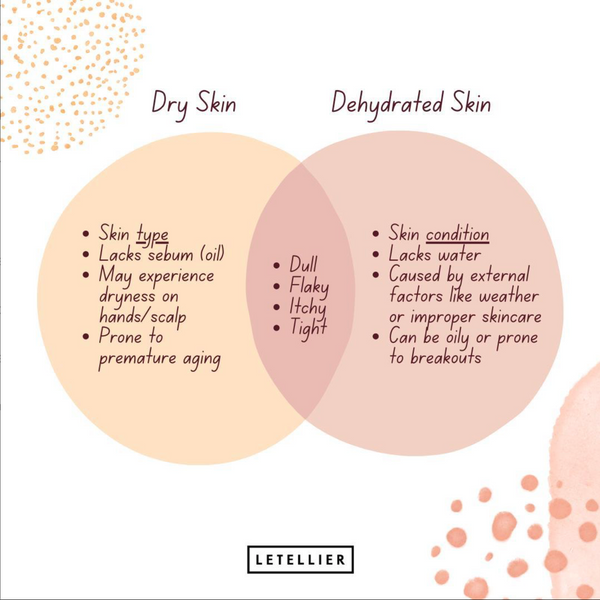What does dry skin look like?
Dry skin is a common condition where the skin doesn’t produce enough lipids, causing it to appear dull, rough, and flaky. If you have small pores or can barely see them, this could mean that your skin type is dry.
What’s the difference between dry skin and dehydrated skin?
Dry skin lacks oil and is more prone to premature aging. Dehydrated skin, on the other hand, lacks water and can be seen in all skin types. Even oily skin can be dehydrated.

Who gets dry skin?
If you have dry skin, it could be your skin type, which is determined by your genetics or ethnicity. Dry skin can affect both men and women, but most people experience dry skin at some point in their lives because our skin changes over time. There’s an increased risk of dry skin in older people, particularly over 60, because our lipid production slows down as we age.
What causes dry skin?
Both external and internal factors can trigger dry skin. Excessive itching from dry skin is also associated with inflammation and bleeding.
|
External causes |
Internal causes |
|
Long, hot showers |
Skin disorders (dermatitis, eczema, psoriasis) |
|
Excessive cleansing |
Diabetes |
|
Using harsh, alkaline soaps |
Hormones (pregnancy, menopause) |
|
Cold weather |
Adverse effect from medication |
|
Low humidity |
Sjögren's syndrome |
|
Dry indoor heat |
Dehydration |
How do you prevent or treat dry skin?
Dry skin is more sensitive because the barrier function is not as healthy due to a lack of lipids. If you suffer from dry skin, focus on moisturizing to restore the lipids in your epidermis and optimize your skin barrier function.
|
Avoid these: |
Do these instead: |
|
Hot showers and aggressive skin washing, which can strip the skin of its protective oils. |
Use lukewarm water to cleanse your skin. |
|
Using harsh body soaps on your face as they alkalize the skin and worsen dry skin. |
Use a mild cleanser like The Bare Bar. Its slightly acidic pH closely resembles the skin's natural pH. Although it’s a bar, it’s less irritating than traditional soaps. |
|
Using a water-based lotion. |
Oil-based moisturizers like The Holy Grail are thicker in consistency and more effective in preventing transepidermal water loss. |
|
Applying your moisturizer on dry skin. |
Apply your moisturizer on damp skin immediately after showering, as this will decrease evaporation. |
|
Sleeping in a low-humidity environment. |
Using a humidifier, especially during the winter months, will improve conditions like dry eye. |
|
Drinking excessive amounts of caffeine and/or alcohol. |
Stay hydrated with adequate water intake. |
What ingredients may improve skin hydration?
Moisturizers, including most oils and butters, lay on top of the skin to reduce transepidermal water loss (TEWL). They help minimize dryness by holding in moisture and protecting the skin barrier.
|
Humectants |
Emollients |
|
Hyaluronic acid and glycerin are well-known humectants that attract water from the dermis (or a humid environment) to the skin’s surface. As we age, the skin doesn't produce HA as fast, resulting in dryer skin. Use a professional-grade serum filled with humectants like The Collagen Booster to help reduce fine lines and wrinkles, two symptoms often associated with dry skin. |
Emollients are naturally found in plant-derived lipids like sunflower seed oil, shea butter, and rosehip extract and can fill gaps and fissures in the skin. Using a facial oil like The Moon Shine as a hydrating night serum will add extra hydration and help improve skin repair. |
Some individuals may experience life-long dry skin, but most cases can be managed with a proper skincare regimen customized for dry skin. If you suffer from dry skin, download our free facial guide, How to Treat Dry Skin at Home in 10 Simple Steps.









